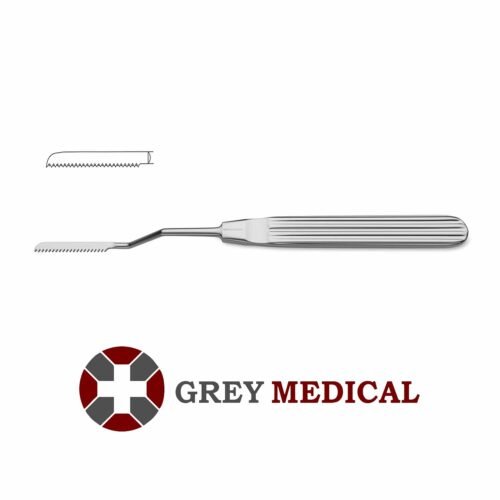Surgical Bone Saw: Essential Tool for Orthopedic and Trauma Surgeries
Surgical Bone Saw: Essential Tool for Orthopedic and Trauma Surgeries
Blog Article
A surgical bone saw is a specialized instrument used in orthopedic, trauma, and reconstructive surgeries for cutting through bone or hard tissues. It is an indispensable tool in procedures requiring precision, such as amputations, bone resections, or corrective surgeries. surgical Bone saws are available in various designs and mechanisms to suit different surgical requirements, ensuring accuracy, safety, and efficiency.

Types of Surgical Bone Saws
Surgical bone saws come in different forms, depending on their use and operating mechanism. The most common types include:
1. Gigli Saw
- Design:
- A flexible wire saw with sharp, serrated edges, used by manually pulling it back and forth around the bone.
- Applications:
- Commonly used in amputations or surgeries in confined spaces where traditional saws cannot be used.
- Advantages:
- Lightweight, compact, and easy to handle in complex surgical scenarios.
2. Oscillating Saw
- Design:
- Features a powered blade that moves back and forth in a small arc.
- Applications:
- Frequently used in orthopedic procedures, such as cutting bones during joint replacement or removing casts.
- Advantages:
- Provides precise cuts with minimal vibration and reduces the risk of soft tissue damage.
3. Reciprocating Saw
- Design:
- A powered blade that moves in a linear back-and-forth motion, resembling a traditional wood saw.
- Applications:
- Used in trauma surgeries or when precise cuts are needed on larger bones.
- Advantages:
- Offers greater control and is ideal for removing bones or performing amputations.
4. Circular Bone Saw
- Design:
- Features a rotating circular blade powered by an electric or pneumatic motor.
- Applications:
- Often used in cranial surgeries, such as craniotomies, to remove sections of the skull.
- Advantages:
- High precision and efficiency for cutting hard bone.
5. Handheld Surgical Saw
- Design:
- A manual saw with a straight or curved blade, typically used for smaller bone cuts.
- Applications:
- Used in minor orthopedic surgeries or for trimming bone fragments.
- Advantages:
- Simple design, easy to use, and does not require power.
Applications of Surgical Bone Saws
Bone saws are utilized in a variety of surgical procedures, including:
- Orthopedic Surgery
- Cutting and reshaping bones during joint replacement surgeries (e.g., hip or knee replacements).
- Performing osteotomies (bone cutting) for correcting deformities.
- Removing bone tumors or fragments in trauma cases.
- Cranial Surgery
- Circular bone saws are used to create openings in the skull for neurosurgical access.
- Amputations
- Gigli saws or reciprocating saws are often used to perform amputations efficiently and cleanly.
- Dental and Maxillofacial Surgery
- Bone saws are used to cut through the jawbone or other hard tissues during reconstructive or corrective procedures.
- Veterinary Surgery
- Bone saws are also used in animal surgeries for fracture repairs, amputations, or dental procedures.
Features of Surgical Bone Saws
- Precision Cutting:
- Designed to make clean and precise cuts, reducing the risk of splintering or fracturing the bone.
- Ergonomic Design:
- Instruments are designed for surgeon comfort and control, reducing hand fatigue during lengthy procedures.
- Material:
- Constructed from surgical-grade stainless steel for durability, corrosion resistance, and ease of sterilization.
- Power Source:
- Powered saws are typically driven by electric motors, pneumatic systems, or battery packs for consistent performance.
- Safety Features:
- Many bone saws are equipped with guards or depth controls to minimize the risk of accidental injury or soft tissue damage.
Advantages of Surgical Bone Saws
- Efficiency:
- Powered bone saws enable faster and more accurate cuts compared to manual instruments.
- Minimized Tissue Damage:
- Oscillating and reciprocating saws are designed to cut bone without damaging surrounding soft tissues.
- Versatility:
- Available in various designs and mechanisms to suit a wide range of surgical applications.
- Ease of Use:
- Ergonomic designs and modern technologies make these instruments easy to operate, even during complex procedures.
- Reduced Surgeon Fatigue:
- Powered saws reduce the physical effort required, allowing surgeons to focus on precision.
Maintenance and Care
Proper care and maintenance are crucial to ensure the performance and longevity of surgical bone saws:
- Cleaning:
- Thoroughly clean the saw immediately after use to remove bone fragments, blood, and tissue debris.
- Use brushes to clean intricate parts, such as serrations and joints.
- Sterilization:
- Sterilize the instrument using autoclaving or other approved methods to maintain aseptic conditions.
- Inspection:
- Regularly inspect the saw for wear, damage, or dull blades. Replace worn parts to maintain cutting efficiency.
- Lubrication:
- For powered saws, ensure the moving parts are properly lubricated for smooth operation.
- Storage:
- Store the saw in a sterile, dry environment to prevent corrosion or contamination.
Limitations and Precautions
While surgical bone saws are highly effective, certain precautions should be taken:
- Training Required:
- Surgeons and operating room staff must be adequately trained in the proper use of bone saws to avoid complications.
- Risk of Heat Generation:
- Powered saws can generate heat during operation, which may damage surrounding tissues. Cooling techniques (e.g., saline irrigation) should be employed when necessary.
- Blade Wear:
- Dull blades can cause splintering or incomplete cuts, increasing surgical difficulty. Regular blade maintenance is essential.
Conclusion
The surgical bone saw is a critical instrument in modern medicine, facilitating precise and efficient bone cutting in a wide range of procedures. Whether manual or powered, these tools are designed to enhance surgical outcomes by offering precision, safety, and ease of use. Proper care, maintenance, and training ensure their optimal performance, making them an invaluable asset in orthopedic, trauma, cranial, and maxillofacial surgeries. Report this page